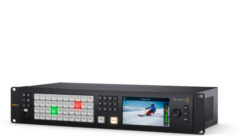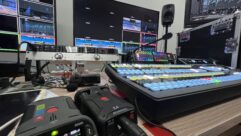
The company behind TrueCut Motion High Frame Rate has announced that Kung Fu Panda 4 will be the first full-animation film to utilize the technology in theaters. It is only the fifth film to see a TrueCut Motion theatrical release.
According to Pixelworks, TrueCut Motion stands apart from other HFR formats by allowing filmmakers to fine-tune each scene’s motion effects shot by shot to keep the cinematic “feel” of the film intact, unlike earlier attempts at theatrical HFR.
LG and Odeon create world’s first all-LED cinema with Dolby Atmos
“The high quality, visual artistry of this amazing, animated work — the first new “Kung Fu Panda” film in almost a decade —will come to premium theatrical screens in cinematic high-frame-rate; achieving dramatically new crystal clear motion playback on the brightest, exceptional high-contrast, high-quality 3D and 2D screens that naturally enhance the look and the feel of the world of the film,” says Pixelworks in their announcement.
Kung Fu Panda 4 will play in TrueCut Motion HFR in both 2D and 3D only in select theaters, which have not yet been revealed. Otherwise, the film will play in standard 24fps.
TrueCut Motion HFR made the scene on Avatar 2: The Way of Water. At the time, Pixelworks posted this explainer:
What is TrueCut Motion?
TrueCut Motion is an advanced software platform that provides filmmakers with a broad new palette of motion looks that were previously not possible. We call the process “Motion Grading” because like color grading, it allows filmmakers to fine-tune the look of their picture, in post, but for motion. Uniquely, TrueCut Motion allows for all the advantages of high frame rate, while retaining the cinematic 24fps look. Beyond this, the platform includes motion grading tools for adjusting judder, shutter angle and speed ramps, shot by shot, in post. The platform works with both theatrical and home entertainment releases and offers a certification program for consumer electronics brands such as TV makers. \
What does TrueCut Motion do exactly?
TrueCut Motion allows filmmakers to essentially re-shoot in post, adjusting the shutter speed, frame rate, judder level and cinematic look, regardless of whether the original was shot in HFR, or in standard 24fps. The judder level adjustment uniquely goes beyond what is possible incamera, by retaining a 24fps cinematic look, while reducing the judder as much or as little as needed, shot by shot.
Why is this necessary in the first place?
Two reasons. First, motion grading provides a creative tool that filmmakers can use to tune their motion look and even create new motion looks that have never been possible before. Like color, sound, lighting, and cinematography, motion looks can now be used as part of a creative palette. Second, motion grading can normalize the judder and shutter look across different displays for a consistent delivery of creative intent. Brighter and more detailed screens cause motion judder and a choppy shutter look, but by motion grading, finishing teams can remove these motion artifacts. This has recently become increasingly important, as the latest displays, both in the cinema and the home, are very significantly brighter and more detailed than at any time since the 24fps movie standard was created around a hundred years ago.
But I hate that “HFR” look!
With motion grading, HFR is no longer a look, but a tool within which any motion look can be delivered. When motion grading is used as part of HFR, the result is cinematic and no longer looks motion smoothed. That’s because motion grading maintains the 24fps cinematic look.
Is it a kind of Variable Frame Rate?
No. A variable frame rate has variable frame rate looks, but filmmakers typically want a 24fps look so VFR doesn’t really work for cinematic content.
So, Avatar 2 is in HFR and used TrueCut Motion technology?
Most screenings of Avatar: The Way of Water are in 48fps HFR. Selective motion grading was applied throughout the movie by Pixelworks, using TrueCut Motion.
Got it, but Avatar 2 is only in High Frame Rate for part of the film, right?
The entire film is actually screened at 48fps. Some shots are “double printed” to achieve a pure 24fps look. Others were shot and played back at pure 48fps. TrueCut Motion was used where neither of these looks worked, to achieve something in-between the two.
Is TrueCut Motion only for 3D movies?
Any film, 2D, 3D, at any native frame rate, when motion graded with TrueCut Motion — will look better. With 3D movies the immersive nature of 3D means that judder is a much bigger problem, and when the 3D title was converted from 2D, there is a shutter angle mismatch as well. Motion grading solves both of these issues. But 2D titles can suffer from judder just as much since they tend to be brighter than 3D. Higher brightness screens such as IMAX, Dolby Cinema and all the latest HDR television sets, can end up with even worse motion artifacts than 3D in fact.
Do content creators have to capture at a high frame rate to use motion grading?
The TrueCut Motion tools accept any source frame rate. For the remastered releases of Avatar and Titanic for example, we are working with 24fps sources. But the higher the source frame rate, the broader the range of creative options in the tool.










